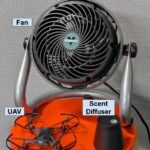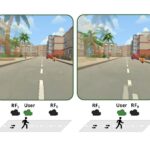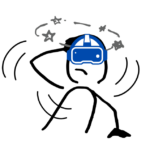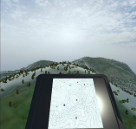2025
|
 | Hiroshi Furuya; Jasmine Joyce DeGuzman; Zubin Datta Choudhary; Matthew Gottsacker; Gerd Bruder; Gregory F. Welch How Does Presence Affect Trust in Simulated Autonomous Agents? Proceedings Article In: Proceedings of the 2025 IEEE Conference on Virtual Reality and 3D User Interfaces Abstracts and Workshops (IEEE VRW): 1st Annual Workshop on Real and Virtual Spaces Influences (ReVISI), pp. 1-2, 2025. @inproceedings{Furuya2025hc,
title = {How Does Presence Affect Trust in Simulated Autonomous Agents?},
author = {Hiroshi Furuya and Jasmine Joyce DeGuzman and Zubin Datta Choudhary and Matthew Gottsacker and Gerd Bruder and Gregory F. Welch},
url = {https://sreal.ucf.edu/wp-content/uploads/2025/10/How_Does_Presence_Affect_Trust_in_Simulated_Autonomous_Agents.pdf},
doi = {10.1109/VRW66409.2025.00109},
year = {2025},
date = {2025-03-08},
urldate = {2025-03-08},
booktitle = {Proceedings of the 2025 IEEE Conference on Virtual Reality and 3D User Interfaces Abstracts and Workshops (IEEE VRW): 1st Annual Workshop on Real and Virtual Spaces Influences (ReVISI)},
pages = {1-2},
abstract = {Autonomous agents present important novel capabilities for a wide swath of applications like simulating interactions between humans and agents. Simulating these interactions in VR has become an important tool for evaluating the effects of agents on human behavior and performance, including human-agent trust. This position paper presents research opportunities in the use of real-world multi-modal feedback and real-world priming experiences may have on the validity of trust measurements taken from simulated human-agent interactions in VR. In addition, it presents a hypothetical experiment addressing research questions related to this topic.},
keywords = {},
pubstate = {published},
tppubtype = {inproceedings}
}
Autonomous agents present important novel capabilities for a wide swath of applications like simulating interactions between humans and agents. Simulating these interactions in VR has become an important tool for evaluating the effects of agents on human behavior and performance, including human-agent trust. This position paper presents research opportunities in the use of real-world multi-modal feedback and real-world priming experiences may have on the validity of trust measurements taken from simulated human-agent interactions in VR. In addition, it presents a hypothetical experiment addressing research questions related to this topic. |
 | Tongyu Nie; Courtney Hutton Pospick; Ville Cantory; Danhua Zhang; Jasmine Joyce DeGuzman; Victoria Interrante; Isayas Berhe Adhanom; Evan Suma Rosenberg Peripheral Teleportation: A Rest Frame Design to Mitigate Cybersickness During Virtual Locomotion Journal Article In: IEEE Transaction on Visualization and Computer Graphics, pp. 1-10, 2025, (Best Paper Award, IEEE VR 2025). @article{nie2025pt,
title = {Peripheral Teleportation: A Rest Frame Design to Mitigate Cybersickness During Virtual Locomotion},
author = {Tongyu Nie and Courtney Hutton Pospick and Ville Cantory and Danhua Zhang and Jasmine Joyce DeGuzman and Victoria Interrante and Isayas Berhe Adhanom and Evan Suma Rosenberg},
url = {https://sreal.ucf.edu/wp-content/uploads/2025/02/2025_IEEE_VR__TVCG__Peripheral_Teleportation.pdf},
year = {2025},
date = {2025-02-25},
urldate = {2025-02-25},
journal = {IEEE Transaction on Visualization and Computer Graphics},
pages = {1-10},
abstract = {Mitigating cybersickness can improve the usability of virtual reality (VR) and increase its adoption. The most widely used technique, dynamic field-of-view (FOV) restriction, mitigates cybersickness by blacking out the peripheral region of the user’s FOV. However, this approach reduces the visibility of the virtual environment. We propose peripheral teleportation, a novel technique that creates a rest frame (RF) in the user's peripheral vision using content rendered from the current virtual environment. Specifically, the peripheral region is rendered by a pair of RF cameras whose transforms are updated by the user's physical motion. We apply alternating teleportations during translations, or snap turns during rotations, to the RF cameras to keep them close to the current viewpoint transformation. Consequently, the optical flow generated by RF cameras matches the user's physical motion, creating a stable peripheral view. In a between-subjects study (N=90), we compared peripheral teleportation with a traditional black FOV restrictor and an unrestricted control condition. The results showed that peripheral teleportation significantly reduced discomfort and enabled participants to stay immersed in the virtual environment for a longer duration of time. Overall, these findings suggest that peripheral teleportation is a promising technique that VR practitioners may consider adding to their cybersickness mitigation toolset.},
note = {Best Paper Award, IEEE VR 2025},
keywords = {},
pubstate = {published},
tppubtype = {article}
}
Mitigating cybersickness can improve the usability of virtual reality (VR) and increase its adoption. The most widely used technique, dynamic field-of-view (FOV) restriction, mitigates cybersickness by blacking out the peripheral region of the user’s FOV. However, this approach reduces the visibility of the virtual environment. We propose peripheral teleportation, a novel technique that creates a rest frame (RF) in the user's peripheral vision using content rendered from the current virtual environment. Specifically, the peripheral region is rendered by a pair of RF cameras whose transforms are updated by the user's physical motion. We apply alternating teleportations during translations, or snap turns during rotations, to the RF cameras to keep them close to the current viewpoint transformation. Consequently, the optical flow generated by RF cameras matches the user's physical motion, creating a stable peripheral view. In a between-subjects study (N=90), we compared peripheral teleportation with a traditional black FOV restrictor and an unrestricted control condition. The results showed that peripheral teleportation significantly reduced discomfort and enabled participants to stay immersed in the virtual environment for a longer duration of time. Overall, these findings suggest that peripheral teleportation is a promising technique that VR practitioners may consider adding to their cybersickness mitigation toolset. |
 | Jasmine Joyce DeGuzman; Kaori Hirano; Tabitha Peck; Alice Guth; Evan Suma Rosenberg; Tongyu Nie Reduction of Motion Complexity as an Objective Indicator of Cybersickness in Virtual Reality Proceedings Article In: Proceedings of IEEE Conference on Virtual Reality and 3D User Interfaces (IEEE VR) 2025., pp. 1-9, 2025. @inproceedings{DeGuzman2025Reduction,
title = {Reduction of Motion Complexity as an Objective Indicator of Cybersickness in Virtual Reality},
author = {Jasmine Joyce DeGuzman and Kaori Hirano and Tabitha Peck and Alice Guth and Evan Suma Rosenberg and Tongyu Nie},
url = {https://sreal.ucf.edu/wp-content/uploads/2024/01/2025_IEEE_VR_Motion_Complexity-1.pdf},
year = {2025},
date = {2025-02-25},
urldate = {2025-02-25},
booktitle = {Proceedings of IEEE Conference on Virtual Reality and 3D User Interfaces (IEEE VR) 2025.},
pages = {1-9},
abstract = {Subjective measures, such as the Simulator Sickness Questionnaire (SSQ), Fast Motion Sickness Questionnaire (FMS), and discomfort scores, are widely used to assess cybersickness, but they often interrupt the user experience and are prone to bias. To overcome these limitations, researchers have also investigated objective indicators, though some approaches, such as using physiological data, can be cumbersome and impractical. Based on the loss of complexity hypothesis, which suggests that certain conditions, such as disease or aging, can produce a reduction of complexity in physiological system dynamics, we conducted an initial investigation of the relationship between movement complexity and cybersickness. We analyzed motion tracking collected from two previous cybersickness studies using the d95 score, a complexity metric derived using principal component analysis. The results revealed a systematic relationship between movement complexity and cybersickness across both experiments. Higher discomfort scores were associated with a reduction in complexity, thereby supporting the loss of complexity hypothesis. Furthermore, the 9-DOF complexity measure, which includes both physical head movement and virtual camera motion, was a more sensitive indicator than the 6-DOF measure computed from physical movements alone. These initial findings suggest that movement complexity may be a useful objective indicator for future cybersickness research.},
keywords = {},
pubstate = {published},
tppubtype = {inproceedings}
}
Subjective measures, such as the Simulator Sickness Questionnaire (SSQ), Fast Motion Sickness Questionnaire (FMS), and discomfort scores, are widely used to assess cybersickness, but they often interrupt the user experience and are prone to bias. To overcome these limitations, researchers have also investigated objective indicators, though some approaches, such as using physiological data, can be cumbersome and impractical. Based on the loss of complexity hypothesis, which suggests that certain conditions, such as disease or aging, can produce a reduction of complexity in physiological system dynamics, we conducted an initial investigation of the relationship between movement complexity and cybersickness. We analyzed motion tracking collected from two previous cybersickness studies using the d95 score, a complexity metric derived using principal component analysis. The results revealed a systematic relationship between movement complexity and cybersickness across both experiments. Higher discomfort scores were associated with a reduction in complexity, thereby supporting the loss of complexity hypothesis. Furthermore, the 9-DOF complexity measure, which includes both physical head movement and virtual camera motion, was a more sensitive indicator than the 6-DOF measure computed from physical movements alone. These initial findings suggest that movement complexity may be a useful objective indicator for future cybersickness research. |
2024
|
 | Hiroshi Furuya; Zubin Choudhary; Jasmine Joyce DeGuzman; Matt Gottsacker; Gerd Bruder; Greg Welch Using Simulated Real-world Terrain in VR to Study Outdoor AR Topographic Map Interfaces Proceedings Article In: Proceedings of the International Conference on Artificial Reality and Telexistence and Eurographics Symposium on Virtual Environments (ICAT-EGVE 2024), Tsukuba, Japan, December 1-3, 2024, pp. 1-10, 2024. @inproceedings{Furuya2024topo,
title = {Using Simulated Real-world Terrain in VR to Study Outdoor AR Topographic Map Interfaces},
author = {Hiroshi Furuya and Zubin Choudhary and Jasmine Joyce DeGuzman and Matt Gottsacker and Gerd Bruder and Greg Welch},
url = {https://sreal.ucf.edu/wp-content/uploads/2024/10/cameraready_ICAT_EGVE_2024_1029_topographic_map.pdf},
doi = {tbd},
year = {2024},
date = {2024-12-01},
urldate = {2024-12-01},
booktitle = {Proceedings of the International Conference on Artificial Reality and Telexistence and Eurographics Symposium on Virtual Environments (ICAT-EGVE 2024), Tsukuba, Japan, December 1-3, 2024},
pages = {1-10},
abstract = {Augmented reality (AR) technology enables advanced integration of spatial information useful in a variety of important domains, including for reading topographic maps in the field. It is also important to understand how this technology may potentially affect spatial learning ability. In this paper, we demonstrate the use of virtual reality (VR) to conduct a human-subject study investigating the impacts of different simulated AR topographic map interface designs on spatial learning outcomes. Our results show that interfaces that encourage engagement with the interface instead of with the map and the environment result in fast task completion times but poor spatial learning. We also found participant preference for a novel interface design that assists users with map orientation without explicitly guiding the user through the task.},
keywords = {},
pubstate = {published},
tppubtype = {inproceedings}
}
Augmented reality (AR) technology enables advanced integration of spatial information useful in a variety of important domains, including for reading topographic maps in the field. It is also important to understand how this technology may potentially affect spatial learning ability. In this paper, we demonstrate the use of virtual reality (VR) to conduct a human-subject study investigating the impacts of different simulated AR topographic map interface designs on spatial learning outcomes. Our results show that interfaces that encourage engagement with the interface instead of with the map and the environment result in fast task completion times but poor spatial learning. We also found participant preference for a novel interface design that assists users with map orientation without explicitly guiding the user through the task. |





